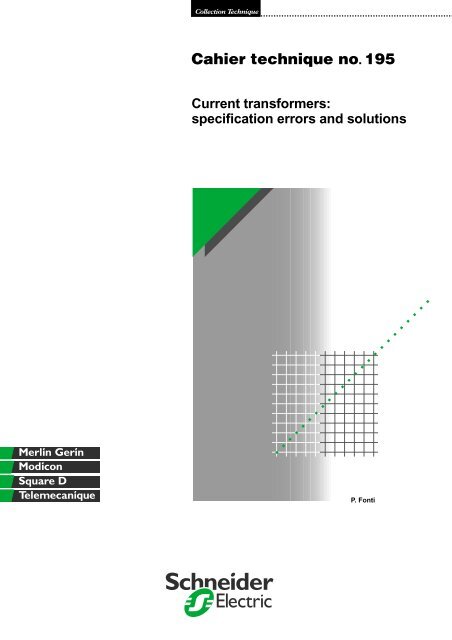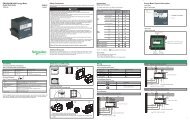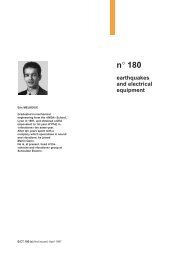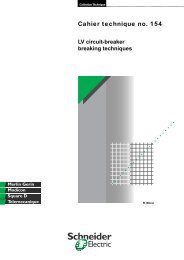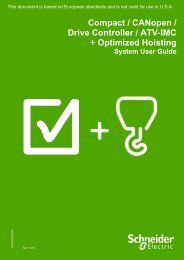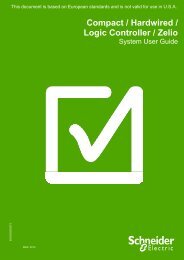Cahier technique no 195 - Schneider Electric
Cahier technique no 195 - Schneider Electric
Cahier technique no 195 - Schneider Electric
Create successful ePaper yourself
Turn your PDF publications into a flip-book with our unique Google optimized e-Paper software.
Collection Technique ..........................................................................<strong>Cahier</strong> <strong>technique</strong> <strong>no</strong>. <strong>195</strong>Current transformers:specification errors and solutionsP. Fonti
"<strong>Cahier</strong>s Techniques" is a collection of documents intended for engineersand technicians, people in the industry who are looking for more in-depthinformation in order to complement that given in product catalogues.Furthermore, these "<strong>Cahier</strong>s Techniques" are often considered as helpful"tools" for training courses.They provide k<strong>no</strong>wledge on new technical and tech<strong>no</strong>logical developmentsin the electrotechnical field and electronics. They also provide betterunderstanding of various phe<strong>no</strong>mena observed in electrical installations,systems and equipments.Each "<strong>Cahier</strong> Technique" provides an in-depth study of a precise subject inthe fields of electrical networks, protection devices, monitoring and controland industrial automation systems.The latest publications can be downloaded from the <strong>Schneider</strong> <strong>Electric</strong>internet web site.Code: http://www.schneider-electric.comSection: Experts' placePlease contact your <strong>Schneider</strong> <strong>Electric</strong> representative if you want either a"<strong>Cahier</strong> Technique" or the list of available titles.The "<strong>Cahier</strong>s Techniques" collection is part of the <strong>Schneider</strong> <strong>Electric</strong>’s"Collection <strong>technique</strong>".ForewordThe author disclaims all responsibility subsequent to incorrect use ofinformation or diagrams reproduced in this document, and can<strong>no</strong>t be heldresponsible for any errors or oversights, or for the consequences of usinginformation and diagrams contained in this document.Reproduction of all or part of a "<strong>Cahier</strong> Technique" is authorised with theprior consent of the Scientific and Technical Division. The statement"Extracted from <strong>Schneider</strong> <strong>Electric</strong> "<strong>Cahier</strong> Technique" <strong>no</strong>. ....." (pleasespecify) is compulsory.
<strong>no</strong>. <strong>195</strong>Current transformers:specification errorsand solutionsPaola FONTIINPG engineer (Institut National Poly<strong>technique</strong> de Gre<strong>no</strong>ble).Graduated in 1970.Joined Merlin Gerin in 1981 as consultant and head of the MediumVoltage Export engineering and design department. She is currentlyresponsible for the MV project completion and tender support groupfor <strong>Schneider</strong> <strong>Electric</strong>.ECT <strong>195</strong> first issue, February 2000<strong>Cahier</strong> Technique <strong>Schneider</strong> <strong>Electric</strong> <strong>no</strong>. <strong>195</strong> / p.1
LexiconI f : maximum through current crossing aprotected area.I s : current threshold setting.k n : <strong>no</strong>minal accuracy limit factor (ALF) of a CT(associated with its accuracy load).k r : real ALF of a CT associated with its real load.P i : (= R ct I 2 n ). Internal losses of the CT at I n .P n : (= R n I 2 n ). Accuracy power of the CT.P r : (= R r I 2 n). Real load consumption ofthe CT at I n .R ct : CT secondary winding resistance.R L : wiring resistance.R p : protection relay resistance.ALF: accuracy limit factor.CT: current transformer.Overrating of a CT: selection of a CT whoseprimary I n is greater than the I n immediatelygreater than the load I n .Matching, auxiliary or interposing CT:low voltage CTs installed at the secondary of themain CTs for correcting a ratio and/or the currentphase shift.SF: security factor.<strong>Cahier</strong> Technique <strong>Schneider</strong> <strong>Electric</strong> <strong>no</strong>. <strong>195</strong> / p.2
Current transformers:specification errors and solutionsAfter a reminder of current transformers (CTs), the author highlights theerrors most often encountered when defining current transformers, anessential and little k<strong>no</strong>wn link between the electrical network and theprotection relays.It explains how to find a way out of difficult situations: CTs that can<strong>no</strong>t bemanufactured, delays, additional costs, malfunctions, etc.This <strong>Cahier</strong> Technique should be useful for electricians designinginstallations, for protection specialists, panel builders and all CTmanufacturers. It is in the best interest of all to exchange all informationrequired for the safety and optimisation of CTs.This <strong>Cahier</strong> Technique is an operational addition to <strong>Cahier</strong> Technique<strong>no</strong>. 194 “Current Transformers: how to specify them”.Contents1 Specifying current transformers 1.1 Introduction p. 4properly1.2 Reminder of CTs p. 42 Examples of specification errors 2.1 Optimisation and safety p. 72.2 When CTs do <strong>no</strong>t seem to be suitable… p. 82.3 The most frequent errors p. 92.4 And if the CT can<strong>no</strong>t be manufactured? p. 123 Equivalence of the various possible 3.1 How to move from P n1 -5Pk 1 to P n2 -5Pk 2 p. 15definitions of the same CT3.2 How to move from P n1 -5Pk 1 to P n2 -10Pk 2 p. 153.3 What is the V k of a CT: P n -XPk p. 163.4 How to move from class X (V k , R ct ) p. 16to a class 5P: P n -5Pk4 Conclusion p. 175 Bibliography p. 18<strong>Cahier</strong> Technique <strong>Schneider</strong> <strong>Electric</strong> <strong>no</strong>. <strong>195</strong> / p.3
1 Specifying current transformers properly1.1 IntroductionTraditional current transformers (see <strong>Cahier</strong>Technique <strong>no</strong>. 164) and hybrid currenttransformers (see <strong>Cahier</strong> Technique <strong>no</strong>. 170)form an essential link within the protection chai<strong>no</strong>f electrical networks.Their specification, even if it is handled byspecialists, often includes errors and isinsufficiently optimised.This often leads to tech<strong>no</strong>logical impossibilities,operating delays, extra costs, incorrect operatio<strong>no</strong>f protections and can even jeopardize thesafety of installations and people.Proper specification of CTs (see <strong>Cahier</strong>Technique <strong>no</strong>. 194) requires sound k<strong>no</strong>wledge of:c the electrical installation diagram,c the electrical data (voltage, <strong>no</strong>minal current,short-circuit current, etc.),c the associated protections,c the overall network protections (protectionplan, the load that they represent for the CTs, aswell as wiring and their settings.Often, due to lack of data or even ig<strong>no</strong>rance ofhow a CT shall be used, a CT manufacturer says“these features are <strong>no</strong>t feasible”, while astandard CT may be suitable.Although this <strong>Cahier</strong> Technique emphasisesoptimisation, it particularly stresses theequivalence between the different definitions ofthe same current transformer. You should bearin mind that power, class and accuracy limitfactor are interdependent values, which have <strong>no</strong>significance if taken individually. This k<strong>no</strong>wledgeis a means of finding a way out of many nearlyimpossible situations.Before entering the heart of the matter, a fewreminders of CT characteristics are given in thefollowing sections.1.2 Reminder of CTsAccording to IEC standards (among others), CTscan be defined by:a - Their ratio, example: 2000/5 A.b - Their power, example: 15 VA.c - Their class, example:v 5P, 10P for a protection winding,v class 0.5, 1, etc. for a metering winding.d - The characteristics linked to their saturation:d-1 Accuracy Limit Factor (ALF) for a protectionwinding,d-2 Safety Factor (SF) for a metering winding.e - Other characteristics:v thermal withstand, example 50 kA - 1 sec.,v insulation voltage,v etc.In the reminder of this section, we shall beconcerned only with characteristics a, b, c, and dand their consequences (see fig. 1 ).Protection 2500/1 A 15 VA 5P 20(a) (b) (c) (d-1)Metering 500/5 A 20 VA cl 0.5 F S3(a) (b) (c) (d-2)Fig. 1 : main characteristic values of the CT.<strong>Cahier</strong> Technique <strong>Schneider</strong> <strong>Electric</strong> <strong>no</strong>. <strong>195</strong> / p.4
A 15 VA-5P20 CT has a guaranteed error of less It is the magnetising current I m which generatesthan 5 % when it is subjected to 20 times its a metering error. If the CT were perfect,<strong>no</strong>minal current and delivers into its <strong>no</strong>minal load then I m = 0.(15 VA to I n ).The CT magnetisation curve represents theEach of the characteristics b, c, d is a function ofmagnetising current as a function of voltage Vthe two others.sdeveloped at the CT secondary. It can be dividedThe same CT can be affected a different power, into 3 zones (see fig. 3 ):a different accuracy class and a different ALF. 1 - <strong>no</strong>n-saturated zone,However, a given CT only has one magnetising 2 - intermediate zone,curve and only one secondary winding3 - saturated zone.resistance (at a given temperature).When these last two elements are k<strong>no</strong>wn (curve In zone 1, current I m is low and voltage V sand resistance), we can identify all theincreases almost proportionally to the primarynecessary correspondences between the various current.values a, b, and c to be assigned to the CT or Zone 2 is a vague zone between the <strong>no</strong>nsaturatedzone and the saturated zone. There israther between the various triplet combinations:(b 1 , c 1 , d 1 ) ⇔ (b 2 , c 2 , d 2 ) ⇔ (b i , c i , d i )<strong>no</strong> real break in the magnetisation curve. It ishard to locate a precise point on the curveAll the equivalences are deduced from the corresponding to the saturation voltage.simple laws of electricity, in particular Ohm’s law.In zone 3, the curve (V s I m ) becomes almostCT equivalent diagram (see fig. 2 ).horizontal. The error is considerable on the ratioand the secondary current distorted by thec CT ratio: I / I .n1 nsaturation.2c L m : CT equivalent inductive magnetisation A certain number of characteristic voltages are(saturable).highlighted for a CT: they correspond to zone 2 ;c I m : magnetising current.k<strong>no</strong>wledge of these voltages is necessary whenc I 1 : primary current.a<strong>no</strong>ther definition is given to a particular CT.c I 2 : secondary current corresponding to aIn2perfect CT, i.e. I 2 = I .1In13c I s : secondary current effectively crossing the2→ → →CT secondary: I2= Is + Im .V s1I 1 I 2 I s R ctI n1I n2I mL mV sR p1 - Non-satured zone2 - Intermediate zone3 - Satured zoneI mFig. 2 : a CT equivalent circuit.Fig. 3 : magnetisation curve (excitation) V s = f(I m )of a CT.<strong>Cahier</strong> Technique <strong>Schneider</strong> <strong>Electric</strong> <strong>no</strong>. <strong>195</strong> / p.5
Characteristic voltages linked to a CTc Knee point voltage defined by the BS 3938standard: V k for class X (PX in IEC 60044-1).V k is determined by the point on the curve V s (I m )from which a 10% increase in voltage V s leads toa 50% increase in the magnetising current.c Voltage linked to the accuracy limit of the class5P CTs: V (5P) = Vs 1.c Voltage linked to the accuracy limit of the class10P CTs: V (10P) = Vs 2.c Voltage linked to the safety factor F sV (F ) = Vs s2, since the safety factor is linked to anaccuracy limit of 10 % just like the class 10P CT.These various voltages V k < V (5P) < V (10P) areeach linked to an induction level.With the materials commonly used for CTmanufacturing, for example:c V k corresponds to 1.4 tesla,c V (5P) = Vs 1corresponds to 1.6 tesla,c V (10P) = Vs 2corresponds to 1.9 tesla,c V (F ) = Vs s corresponds to 1.9 tesla.2The following ratios can be deduced:V 1.4V 1.6 ; V 1.4V 1.9 ; Vkks11.6= = =V 1.9 ; etc.s1 s2s2If one of these voltages is k<strong>no</strong>wn, it is simple todeduce the others.How to calculate the characteristic valuesfrom a CT defined in the 5P or 10P class.c Let us take an example:Let us assume a 10 VA-5P15 CT with a ratio of2000/5. “10 VA-5P15” means that when there isa load equal to its <strong>no</strong>minal load RPnp = ,I n 2CT accuracy is guaranteed better than 5% up toI s = 15 I n . From this point on, it is sufficient torefer to the CT equivalent circuit and to Ohm’slaw to obtain the value of V (5P) or V s1(see fig. 4 ).The result is simply: V s = (R ct + R p)I 1 s ,i.e. V s = (R ct + R p) 15 I 1 n .This relation shows that k<strong>no</strong>wledge of theinternal resistance of the CT secondary windingis absolutely necessary to correlate the variouspossible definitions of the CT.We shall say that a good CT definition mustinclude, whatever the case, the value of R ct .In our case, let us assume that R ct = 0.6 Ω,where R 10n = = 0.4 Ω, the calculation yields:25V s1 = 15 x 5 (0.6 + 0.4) = 75 volts.With the induction values mentioned above forthe 10P classes and class X, V s2and V k can becalculated.I 1 I 2 R ctI s = 15 I nI n1 I e VP sR p = nI2n2I nV s1 = (R ct + R p ) I sFig. 4 : calculating the characteristic voltage of a CT.<strong>Cahier</strong> Technique <strong>Schneider</strong> <strong>Electric</strong> <strong>no</strong>. <strong>195</strong> / p.6
2 Examples of specification errors2.1 Optimisation and safetyExamination of a protection plan shows that it isdesigned, for the transformer feeders atswitchboard level, to fit CTs of different ratios50/5 and 1000/5 with the same definition15 VA-5P20.These CTs are associated to the sameovercurrent protection relays with settingsof 15 I n (of CTs) for 50 A feeders, and 12 I n(of CTs) for 1000 A feeders. Same load(0.05 VA), same wiring (1.25 VA) and relaysettings <strong>no</strong>t too much different: it seems logicalthat the two sets of CTs have the same definition.However a quick calculation of the necessarypower shows that this is <strong>no</strong>t the case…c For the 1000/5The necessary ALF (see <strong>Cahier</strong> Technique<strong>no</strong>. 194) is 2 I r , i.e. k r = 24.InK<strong>no</strong>wing that kr=kn ( Pi + Pn) , where:P + Pv an internal resistance R ct = 0.6 Ω,v k n = 20,v CT internal losses at I n = P iPi = Rct x In2 = 06 . x 5 2 = 15 VA,v a real CT load at I n = P n = 1.3 VA,we obtain: k r = 36.8 > 24.The CT is thus more than suitable.c For the 50/5The necessary ALF is 15 I n x 2, i.e. k r = 30.v First of all, such a CT is theoretically <strong>no</strong>tfeasible. Its internal resistance would bearound 0.02 Ω. But we can show that it isoversized in power.v Furthermore, with R ct = 0.02 Ω, P i = 0.5 VA;and with k n = 20 and P p = 1.3 VAwe obtain k r = 172 u 30.ipMore serious still, in event of a trip failure of thetransformer feeder, the short-circuit current (I th ofthe 40 kA /1 s switchboard) will cause an rmscurrent greater than: 172 x 5 A = 860 A to flow atthe CT secondary.(Without saturation 40000 A /50 A x 5A=4kA).The relay and the wiring will be destroyed as wellas the CT.A 5 VA CT is thus more than e<strong>no</strong>ugh(k r = 67 > 30). A 2.5 VA CT is also suitable: it isless expensive, takes up less space and, mostimportant, it can be manufactured.c ConclusionThe power of low ratio CTs must be calculatedas their naturally low R ct induces a risk ofdangerous oversizing.Figure 5 sheds some light on the interactionsbetween k r , P p , P i .k r = real ALF220.0200.0180.0160.0140.0120.0100.080.060.040.0P i = 0.5 VAP i = 2 VAP i = 5 VA20.00.00 2 4 6 8 10 12(P n )P p (VA)Fig. 5 : accuracy limit factor behaviour of three CTs(with different R ct ), of 10 VA-5P20 as a function of thereal load connected to the secondary P p .<strong>Cahier</strong> Technique <strong>Schneider</strong> <strong>Electric</strong> <strong>no</strong>. <strong>195</strong> / p.7
2.2 When CTs do <strong>no</strong>t seem to be suitable…This paragraph traces the difficultiesencountered further to the manufacturing of CTsfor a 33 kV public distribution switchboardconsisting of 8 line feeders, without taking intoaccount final needs. The entire problem came upon site a short while before energisation, whenthe CTs were already installed in the MV panels(see fig. 6 ).c The needs formulated when the contract wasawarded.The aim was to have a double primary 300-600and three 1 A secondary windings:v a 5 VA-5P20, to supply a Sepam 2000protection unit,v a 15 VA classe 0.5, for remote metering,v a class X, for distance protection.c The equipment delivered.As it was impossible to manufacture threewindings in the same functional CT with thesecharacteristics, additional CTs were required.They were dedicated to “class X” and installeddownstream of the double secondary CT.c The error observed on site.CTs operating with distance protection must beinstalled as close as possible to the circuitbreakerto ensure the greatest possibleprotected zone. However the class X CTs were<strong>no</strong>t close e<strong>no</strong>ugh.c What should we do?The proposal was thus made to replace all theCTs, i.e. 2 CTs by phase, 6 CTs by feeder, i.e. atotal of 48 CTs for 8 feeders! Disassembly,manufacture of new CTs and reassembly led toadditional delays and costs…c Was there a<strong>no</strong>ther solution?v An initial possibility was to consider use ofadditional CTs (class X) to supply theSepam 2000. The supplier confirmed thispossibility: the CT dedicated to distanceprotection (class X) corresponds to 10 VA-5P20on ratio 300 and to 20 VA-5P20 on ratio 600/1.It was thus possible to associate the additionalCTs with the Sepam 2000.What a relief! already 24 CTs less to replace.Functional CTs300-600/1 A5 VA-5P20300-600/1 A15 VA-0.5SepamMeteringDistance protectionMeteringAdditional CT300-600/1 Aclass XDistance protectionSepamDelivered arrangementChosen solutionFig. 6 : a 33 kV switchboard CT arrangement: the unsatisfactory diagram and the new solution proposed.<strong>Cahier</strong> Technique <strong>Schneider</strong> <strong>Electric</strong> <strong>no</strong>. <strong>195</strong> / p.8
v The second possibility concerned the CTs withtwo windings: could the 5VA-5P20 windings besuitable for the distance protections?The fact is that, voluntarily, all the CTs wereidentical and corresponded to the worst possiblecase, while the lines were of different lengths(from 2 km to 38 km). The short lines had across-section of 50 mm 2 , the others 150 mm 2 .To come back to the real needs of distanceprotections, it was observed that for 6 feeders,class 5 VA-5P20 corresponded to a suitableclass X whatever CT primary was chosen (300or 600). For the two other feeders, the resultingclass X was satisfactory only on the 600/1 ratio!A solution that the customer accepted for the two150 mm 2 feeders.c We can draw the following conclusion from thiscontract, which reveals all the consequences ofunsatisfactory CT manufacture: the idea ofreplacing all components is often the firstconsidered, but with the help of specialists it ispossible to avoid pointlessly wasting time andmoney.2.3 The most frequent errorsThese errors <strong>no</strong>rmally lead to oversizing of theCTs which increases costs and can be dangerous.Many CT definition errors stem from ig<strong>no</strong>rance oftheir operation and from the unk<strong>no</strong>wn orincomplete characteristics of the networkcomponent to be protected and of the associatedprotections.The better informed the CT manufacturer, thefewer errors and the more the CT will beoptimised.Protections and conventional CTsFor these protections which do <strong>no</strong>t require class Xdefined CTs, the most frequent “errors” are:c Using two CTs or one CT with two secondariesfor two protective relays the manufacturers ofwhich recommend different ALF or differentaccuracy classes. As the CT manufacturers cantranslate 10P to 5P (according to thecorresponding induction levels), and can movefrom one ALF to a<strong>no</strong>ther by adjusting power,they can find a CT matching the needs of bothrelays.c Taking into account the wiring resistancealthough the protection manufacturer hasalready integrated it into the needs formulatedfor the CT.Let us take an example of two relays whosetechnical data indicate for 1 A CTs:CT 1 for relay 1: 5 VA-10P15(assuming 2 R L < 1.5 Ω),CT 2 for relay 2: 10 VA-5P15(assuming 2 R L < 2 Ω).A single CT may be suitable for both relays: intheory a 10 VA-5P15. You need to:v Avoid adding up the powers (5 + 10 VA)required for each relay. In point of fact, for theCT 2 , relay 1 only represents a load (just likewiring) and vice versa.v Check, in this case for the CT 2 , that:2 R L + R p1 i 2 Ω; and if CT 1 was selected, that:2 R L + R p2 i 1.5 Ω. If this was <strong>no</strong>t verified, therelay supplier can suggest that “x” VA be addedper additional ohm.Adding the specified power for severalprotections linked to an application results in CTsthat are often impossible to manufacture or thatjeopardise safety during short-circuits.Use of multifunction numerical relays avoidssuch errors. You only need to size the CT for themost restrictive protection (see <strong>Cahier</strong>Technique <strong>no</strong>. 194).c Changing the required characteristics withoutverifying the consequences.v A CT manufacturer can<strong>no</strong>t make a low ratio CTand suggests increasing this ratio; let us take anexample:- Requested: 30/1 CT - 2.5 VA-5P20,- CT manufacturer’s proposal: 60/1,- With motor I n = 16 A and minimum thermalprotection setting: 40 % of CT I n , i.e.60x0.4=24A.The protection setting at 16 A (<strong>no</strong>rmal thermalprotection setting at motor I n ), is then impossible.The solution is to increase the rating and lowerthe ALF requirement:40/1 - 2.5 VA-5P10. This CT, feasible, allows therequired setting (40 x 0.4 = 16 A).v A buyer accepts a thermal withstand of 0.1 sproposed by the CT manufacturer instead of 1 s.What is likely to happen is that, on a short-circuit,if the real fault duration exceeds 0.1 s, thermaland probably electrodynamic withstand will beinsufficient and may result in CT destruction.c Due to lack of information on real requirements.Let us take the following case, relativelyeducational: a CT with two primaries and threesecondaries (200-1000/1-1-1) is requested with:- the first secondary: 1 A, class X (given V k ),- the second secondary: 1 A-15 VA class 0.5for metering,- the third secondary: 1 A-10 VA-5P20.<strong>Cahier</strong> Technique <strong>Schneider</strong> <strong>Electric</strong> <strong>no</strong>. <strong>195</strong> / p.9
The supplier can propose a CT with threemagnetic cores and secondary tappings to meetthe 200 A or 1000 A need at the primary.However, such a CT is hard to manufacturebecause to obtain 15 VA-class 0.5 and10 VA-5P20 on 200/1 ratios, you need5 x 15 VA-class 0.5 and 5 x 10 VA-5P20 on1000/1 ratios! Moreover, the supplier mustcomply with class X for both ratios!In point of fact, class X concerns only the 1000/1ratio (for busbar differential protection). The200/1 ratios concern metering and the traditionalprotections (see fig. 7 ). The CT to bemanufactured is then easier, less bulky, cheaperand definitely feasible. This example shows thatthe lack of information shared between thoseinvolved is a source of errors and of<strong>no</strong>n-optimisation. A consultation that does <strong>no</strong>tbegin properly may result in a CT that can<strong>no</strong>t bemanufactured.c Taking into account the relay impedance R h forcalculation of real load (see fig. 8 ) in the CTcalculation for overcurrent or in the calculationfor CTs in class X.A word of warning: R h is only considered whencalculating CTs for zero sequence current l h (see<strong>Cahier</strong> Technique <strong>no</strong>. 194).For high impedance differential protections, inthe calculation of V k given by:2 I f (R ct +2 R L +R a ),where R a = other loads, R h must <strong>no</strong>t intervene.This is the load of one phase (we assume that<strong>no</strong> current flows through the neutral).a - The CT manufacturer's understanding200/11000/1Cl. Xb - The real need200/1200/11000/1 1000/115 VA Cl. 0.5 10 VA-5P201000/1200/1200/1Cl. X 15 VA Cl. 0.5 10 VA-5P20Fig. 7 : example of poor understanding between thecustomer and the CT manufacturer.R ct R wiring R O/C relayR ctR ctR wiringR wiringR O/C relayR O/C relayR hFig. 8 : internal and load impedances of a CT.V k is indeed calculated for relay stabilityconditions, i.e. <strong>no</strong> phase or earth fault, in theprotected zone, <strong>no</strong> incorrect unbalance,therefore, in the differential connection I = 0 andthe voltage of that connection = 0.Differential protections and class XFor these applications, the most usual errors are:c Asking the CT manufacturer to supply CTswith the greatest V k that he can build using astandard mould.This occurs when the differential protection relay(make, type) is <strong>no</strong>t defined.There are three consequences:v overcost,v possibility of high overvoltages andovercurrents at the CT secondary which can leadto destruction of the circuit and the relay,v with <strong>no</strong> requirements for the CT R ct , it is <strong>no</strong>tcertain that the V k expression corresponding tothe relay used, will be complied with.To illustrate this case, let us take the example ofa high impedance busbar differential protection.The CT supplied is a 2000/5 where V k = 400 Vand R ct = 2.5 Ω.For the relay used, the expression to be satisfiedis: V k u 200 R ct + 20, i.e. 520 V.The V k = 400 V is <strong>no</strong>t sufficient!More serious still, the requirement of too high aV k may lead to the manufacturing of a <strong>no</strong>nstandardCT (see the first two consequencesabove) requiring a specially designed stabilisingresistance and an overvoltage limitor as well asthe use of a deeper panel!c Error on the through currentThis error is very common. Let us take theexample of a high impedance differentialprotection where the switchboard I sc is taken into<strong>Cahier</strong> Technique <strong>Schneider</strong> <strong>Electric</strong> <strong>no</strong>. <strong>195</strong> / p.10
account instead of the maximum through current.The aim is to protect a motor, the CTs have aratio of 100/1.v Result obtained with the through current(7 I n of CT):V k u 14 (R ct + 2 R L ).v Result obtained with switchboard I sc(I sc = 40 kA):V k u 800 (R ct + 2 R L )It is <strong>no</strong>t necessary to go into too much detail tounderstand the importance of choosing the rightparameter!The table in figure 9 gives the through currentvalues to be taken into account when thethrough current is the CT calculation base (see<strong>Cahier</strong> Technique <strong>no</strong>. 194).c With line differential protections, taking intoaccount the pilot wires in the calculation of R wiring .In point of fact, R L is given by the wiring linkingthe CTs to the relay located on the same side(end) of the line (see fig. 10 ).You must <strong>no</strong>t take into account the length of thepilot wires which run from one end to the other ofthe protected line.RemindersWith respect to high impedance differentialprotections:c For the calculation of min. V k , take account ofthe through current (see fig. 9).c Calculation of the stabilising resistance R st is afunction of min. V k and of the relay settingcurrent.c Calculation of peak voltage (V p ) is based onthe internal I sc of the protected zone and on thereal V k of the CT.Applications Through Imax Excess through CommentsImaxBB differential Switchboard real I scSwitchboard I thTake real I scif <strong>no</strong>protectionincrease possible. Elsetake I thMotor differential Motor starting I 7 I n(motor) If you k<strong>no</strong>w neither theprotection otherwise starting I <strong>no</strong>r the motor I n,7 x I n(CT) take 7 x I n(CT)Generator differential Generator I sccontribution 7 I n(generator) X’’ = generatorprotection only, i.e. I n(100 / X’’) otherwise subtransient reactance7 x I n(CT) as a %. If unk<strong>no</strong>wn, weassume X’’ % u 15i.e. 100/15 = 6.67(7 is taken by excess)Restricted earth fault I scseen at the CT If P aunk<strong>no</strong>wn, we P a= upstream shortdifferentialprotection primary for a fault at the take circuit power and P t=transformer secondary, P sc= P tpower limited byi.e. I sc= P sc/Ue P t= P n(100 / Z sc) transformerP sc= (P t.P a) / (P t+ P a)Z sc% = transformershort-circuit impedanceLine differential I scat 80 % of line Switchboard I thby Switchboard I thbyprotection default defaultFig. 9 : determining the through current properly.R LPilot wires (several kilometers)R LFig. 10 : R L is given by the wiring between the CT and the relays located on the same side of the line.<strong>Cahier</strong> Technique <strong>Schneider</strong> <strong>Electric</strong> <strong>no</strong>. <strong>195</strong> / p.11
2.4 And if the CT can<strong>no</strong>t be manufactured?When a CT manufacturer says that he is unableto manufacture the requested CT, nine times outof ten this is because the CT has beenincorrectly specified. To eliminate all thecumulated safety margins taken by all the peopleinvolved, the CT must be redefined on the basisof real needs:c real currents in the installation,c types of protection, required power,c discrimination study and protection plan(settings).This approach must be adopted whenever thespecification leads to a <strong>no</strong>n standard CT. Costs,lead times and safety are the factors at stake.Let us take an example:We have calculated the class X of a 1000/5 CTfor a generator differential protection, assumingthat X’’ = 15 %.Not k<strong>no</strong>wing the exact characteristics of thegenerator, we have assumed that the generatorI n equals the CT I n .This results in: If= 100 In of the CT15i.e. V k u 2 x 6.7 x 5 (R ct + 2 R L )We have rounded off 6.7 as 7.We assumed:2 R L = 300 m of 2.5 mm 2 , i.e. 2.4 Ωhence: V k u 70 R ct + 168.Since this CT requires two other windings, thisvalue could <strong>no</strong>t be achieved using the standardmould.The solution was found by using 4 mm 2connections and by requesting the generatorcharacteristics. Then:2 R L = 1.5 ΩGenerator I n = 830 A.X’’ = 25 %, hence:V k u 2 x830 x 10025x51000(R +1.5) ctV k = 33.2 R ct + 50The difference is marked and shows theimportance of obtaining the right information andof k<strong>no</strong>wing the safety margins.If the CT is declared impossible to manufacture,a solution, i.e. a compromise, must be foundbetween all those involved. There is always away out, which can be found with the help ofspecialists.As an example, here are a few leads:c play on the equivalences between CTs (seenext section),c reduce the safety coefficient (for instance2 to 1.5 for an overcurrent protection),c change the secondary from 5 to 1 A (see fig. 11 ),c increase wiring cross-section,c overrate the CTs (primary I n ),c move the relay with respect to the CT,c use matching CTs with low consumption,c and so on.The overrating of a CT can solve amanufacturing problemLet us take two examples:c A 100/1 CT with a load of 2.5 VA requires anALF of 25 for an overcurrent protection.The standard CTs proposed are 2.5 VA-5P20. Ifa CT with a ratio of 150/1 - 2.5 VA-5P20 isproposed, the ALF need will be reduced in theCT primary ratio, i.e. necessaryALF = 25 x (100/150) = 16.7. An ALF of 20 isthus sufficient!c If the class X requested for a CT isproportional to a through current or a primary I sc ,these values are multiplied by the CT ratio; thus,the required knee point voltage will be less for a<strong>no</strong>verrated CT, unless its increasing resistanceR ct starts to neutralise the ratio benefit.In all cases, it will be possible to create a higherknee point voltage than with a CT of lower ratio,as it is proportional to the number of secondaryturns.Globally, the chance of obtaining workablecharacteristics will be greater.The same reasoning can be made for a 1 Asecondary CT compared with a 5 A CT.However, the factor gain of 5 obtained on theformula by the CT ratio is often completelyerased, if <strong>no</strong>t reversed, by a far greater increaseof secondary winding resistance.Length (m) 5 10 20 50 100 200 400Wiring losses (VA) for:I n= 1 A 0.04 0.08 0.16 0.4 0.8 1.6 3.2I n= 5 A 1 2 4 10 20 40 80Fig. 11 : losses in wiring for a 2.5 mm 2 cross-section (8 Ω/km at 20° C). With 1 A, losses are 25 times less.<strong>Cahier</strong> Technique <strong>Schneider</strong> <strong>Electric</strong> <strong>no</strong>. <strong>195</strong> / p.12
Indeed, the space required for the number ofturns x 5 results in reduction in wiring crosssection,thus naturally increasing its linearresistance. The new resistance can thus beamply multiplied by 10 with respect to the 5 A CT.c If you are tempted to impose a CT overrating,you must check the repercussions of the changein ratio.For example:v If the CT supplies a pilot wire differentialprotection, you must ensure that thecorresponding CT at the other end of the line hasalso the same ratio change.v In the case of a restricted earth protection, youmust ensure that:- the CT installed on the neutral point is alsomodified,- the earth fault detection is <strong>no</strong>t compromised bythe overrating.v For all protection types, you must check thatsetting of the protection is still possible.Optimisation of the differential protection CTsLet us take the example of a transformerdifferential protection (see fig. 12 ).c Calculating the through current.The transformer impedance limits the through5 x 100current to: (P sct = = 62.5 MVA) .8v Short-circuit power becomes:600 62.5P sc = x56.6 MVA600+62.5=.v The through current at the secondary is:- 11 kV side:656.6 x 10I f1 3x 10 x 5= = 49.5 A ,11 3 300- 3.3 kV side:656.6 x 10If2 3. x 10 x 5= = 49.5 A ,33 3 1000c Formulas to be applied for V k (standardprotection):v Calculating the matching CTs5with a ratio of:5/3V ka mini[ ]4I= f1 R sr + 3 ( R L3 + Rp)3v Calculating main CTs- 11 kV side: 300/5V k p1 min = 4I f1 (R ct + R L1 + R sp ) + V ka mini- 3.3 kV side: 1000/54 I (R R R )V k p2 min = f2 ct + L2 + r55 3Distance500 mI sc = 31.5 kA (P sc 600 MVA)300/51000/511 kV3.3 kV5 MVAZ sc = 8 %R L1R rR L2Fig. 12 : transformer differential protection.87TR L3c Optimisation approach.Let us examine the case of the 300/5 CT placedin the 11 kV switchboard.v First hypothesis5The matching CT is the one proposed as5/3standard by the relay manufacturer. It is locatedwith the relay on the 3.3 kV side. Wiring is2.5 mm 2 throughout.R L1 = 4 ΩR L2 = 0.08 ΩR L3 = 0.024 ΩR sr = 0.25 Ω, secondary winding resistance ofthe matching CT,R sp = 0.15 Ω, primary winding resistance of thematching CT,R p = 0.02 Ω, relay resistance.We find:- V ka mini = 43.7 V (standard V ka = 58 V),- V kp1 mini = 198 R ct + 847<strong>Cahier</strong> Technique <strong>Schneider</strong> <strong>Electric</strong> <strong>no</strong>. <strong>195</strong> / p.13
v Second hypothesisThe same as the first, except that R L1 wiring is in10 mm 2 , hence R L1 = 1 ΩThe result is:- V kp1 mini = 198 R ct + 243v Third hypothesisThe matching CT is on the 11 kV side as well asthe relay: R L1 = 0.08 Ω- V kp1 mini = 198 R ct + 61v Fourth hypothesisSame as the third hypothesis, except for thematching CT which is <strong>no</strong>t standard, but which isimposed on the CT manufacturer where:R s i 0.1 Ω,R p i 0.1 Ω,which results in:- V ka mini = 26.5 V- V kp1 mini = 198 R ct + 41We observe that by modifying the wiringcross-section, the position and thecharacteristics of the matching CT, the gain onthe minimum needed V k of the 300/5 CT isaround 800 V.The same approach adopted for the 1000/5 CT,placed on the 3.3 kV side, yields results that arefairly similar concerning V k . However, in view ofthe fact that a 1000/5 CT is easier tomanufacture than a 300/5 CT, it is moreadvantageous to place the relay and thematching CT on the 11 kV side.If a 1 A CT is used, the same hypotheses asabove enable a move from:- V kp1 = 39.6 R ct + 249 to V kp1 = 39.6 R ct + 17The 1 A CTs may be easier to manufacture thanthe 5 A CTs, but all depends on the relativeweight of the R ct and the wiring in the V kexpression.<strong>Cahier</strong> Technique <strong>Schneider</strong> <strong>Electric</strong> <strong>no</strong>. <strong>195</strong> / p.14
3 Equivalence of the various possible definitions of the same CTIn many cases, you need to k<strong>no</strong>w how to “juggle”with the various CT characteristics; ratio, power,class, ALF. The reason for this is <strong>no</strong>t only i<strong>no</strong>rder to get out of a tricky position, but also to beable to use standard CTs that are available, lesscostly and tested.This section thus aims to show how CTcharacteristics can be manipulated. First,however, it should be pointed out that the onlyCT constants are its magnetising curve andresistance and, naturally, its ratio.3.1 How to move from P n1 -5Pk 1 to P n2 -5Pk 2V s1and R ct are fixed.⎛V R P n ⎞ ⎛k R P n ⎞12s = ct +n ct k1 ⎜ ⎟ 1I= ⎜ + ⎟ 2 I2 2⎝ I ⎠ ⎝ I ⎠n⎛R P n ⎞i= ⎜ ct + ⎟ k I2⎝ I ⎠ni n2K<strong>no</strong>wing that P i = R ct I n(internal ohmic lossesof the CT), we obtain:(P i + Pn) k 1 = (P i + P n ) k 2 = (P i + P k1 2n )3 3.Sometimes, some people ig<strong>no</strong>re P i : this is aserious error as P i can be roughly of the samevalue, if <strong>no</strong>t higher, than P n .nnc if P n2 is imposed, we shall obtain:k 2 =2( Pi+ P n )( P ) k or k ( R P )1ct In+ n11 2 =( P ) k21Pi+ nRctIn+ n2c if k 2 is imposed, we shall obtain:kP n2 =1+ ⎛ ⎞⎝ ⎜ kP1n - 1k k⎟ P1i⎠or else:2k2P n = 1 + ⎛ ⎞2n⎝ ⎜ kP 1n - 1k k⎟ RctI122 ⎠223.2 How to move from P n1 -5Pk 1 to P n2 -10Pk 2We have:VV⎛ P= ⎜Rct +⎝ In1s 1 2n⎛ P= ⎜Rct +⎝ In2s 2 2nBut:V1.6= Vs19 .s 1 2⎞⎟ k⎠c if P n2 is imposed:⎞⎟ k⎠I1 nI2 nc if k 2 is imposed, we shall have:1.9 k 19P n = + ⎛ ⎞12⎝ ⎜ . kP1n- 1 ⎟ R1ct1.6 k216 . k2⎠If you wish to move from a 10P to a 5P definition,the above expressions apply: just reverse theinduction ratio.I2nk 2k 2==21.9( RctIn+ P )n11.6 ( P ) k or21RctIn+n21.9( Pi+ P )n11.6 ( P ) k 1Pi+n2<strong>Cahier</strong> Technique <strong>Schneider</strong> <strong>Electric</strong> <strong>no</strong>. <strong>195</strong> / p.15
3.3 What is the V k of a CT: P n -XPkHow to move from P n -5Pk to V kWe have seen that:⎛ Pn⎞1V s = R ct k1 ⎜ +2 ⎟ In⎝ In⎠1.4and Vk=1.6 V s1hence V 1.4 ⎛1.6 R P ⎞nk = ⎜ ct + ⎟ k I2⎝ I ⎠nnHow to move from P n -10Pk to V kWe also have:V1.41.9 Vk = s 2henceV 1.4 ⎛1.9 R P ⎞nk = ⎜ ct + ⎟ k I2⎝ I ⎠nn3.4 How to move from a class X (V k , R ct ) to a class 5P: P n -5Pkc Assuming that k is imposed, we shall obtain:Pn1.6 ⎛ V=k In⎞⎜ ⎟ - R1.4 ⎝ k ⎠ct In2If the result is negative, this means that thenecessary ALF can<strong>no</strong>t be obtained with this CTas its internal losses are too great.c Assuming that P n is imposed, in this case:k1.6 ⎛= ⎜1.4 ⎝ P nVkIn+ Rct⎞⎟In2⎠Note:In this section, the induction levels: 1.4 - 1.6 - 1.9are given as examples since they vary from onemanufacturer to a<strong>no</strong>ther.<strong>Cahier</strong> Technique <strong>Schneider</strong> <strong>Electric</strong> <strong>no</strong>. <strong>195</strong> / p.16
4 ConclusionThis <strong>Cahier</strong> Technique completes <strong>Cahier</strong>Technique <strong>no</strong>. 194 in its aim to increaseawareness of all those involved in the processfrom design of an electrical network toimplementation of protections, of the time wastedand the financial losses resulting from incorrectspecification of CTs. In particular, it gives someexamples of errors <strong>no</strong>t to make and leads forsolutions when the original specification is <strong>no</strong>tsatisfactory or when you apparently come upagainst a dead end.It stresses that although communication with theCT manufacturer and particularly k<strong>no</strong>wledge ofinduction levels enables a solution to be foundby playing with equivalences, it is by identifyingthe exact needs at all stages in the process, thatthe optimised solution can be found.We hope that you will find this document useful.<strong>Cahier</strong> Technique <strong>Schneider</strong> <strong>Electric</strong> <strong>no</strong>. <strong>195</strong> / p.17
BibliographyStandardsc IEC 60185: Current transformers -Characteristics.c IEC 60044-1: Instrument transformers - Part 1:Current transformers (replaces the IEC 185).c IEC 60044-8: Instrument transformers - Part 8:Electronic current transformers.c NF C 42-502: Measuring instruments. Currenttransformers. Characteristics.c BS 3938 (replace by BS 7626): Specificationfor current transformers.<strong>Schneider</strong> <strong>Electric</strong>’s <strong>Cahier</strong>s Techniquesc Protection des machines et des réseauxindustriels HT.P. ROCCIA, <strong>Cahier</strong> Technique <strong>no</strong>. 113.c Current transformer for HV protection.M. ORLHAC, <strong>Cahier</strong> Technique <strong>no</strong>. 164.c Protection of industrial and tertiary MVnetworks.A. SASTRE, <strong>Cahier</strong> Technique <strong>no</strong>. 174.c Directional protection equipment.P. BERTRAND, <strong>Cahier</strong> Technique <strong>no</strong>. 181.c Dynamic stability of industrial electricalnetworks.B. DE METZ NOBLAT and G. JEANJEAN,<strong>Cahier</strong> Technique <strong>no</strong>. 185.c Current transformers: How to specify them.P. FONTI, <strong>Cahier</strong> Technique <strong>no</strong>. 194.Various worksc Guide de l’ingénierie électriqueELECTRA - 07.86c Protection des réseaux électriquesCh. PREVE - Ed. Hermes - 06.98<strong>Cahier</strong> Technique <strong>Schneider</strong> <strong>Electric</strong> <strong>no</strong>. <strong>195</strong> / p.18
<strong>Schneider</strong> <strong>Electric</strong>Direction Scientifique et Technique,Service Communication TechniqueF-38050 Gre<strong>no</strong>ble cedex 9Fax: (33) 04 76 57 98 60DTP: Axess - Saint-Péray (07)Edition: <strong>Schneider</strong> <strong>Electric</strong>Printing: Imprimerie du Pont de Claix - Claix - France - 1000- 100 FF -© 2000 <strong>Schneider</strong> <strong>Electric</strong>03759702-00


